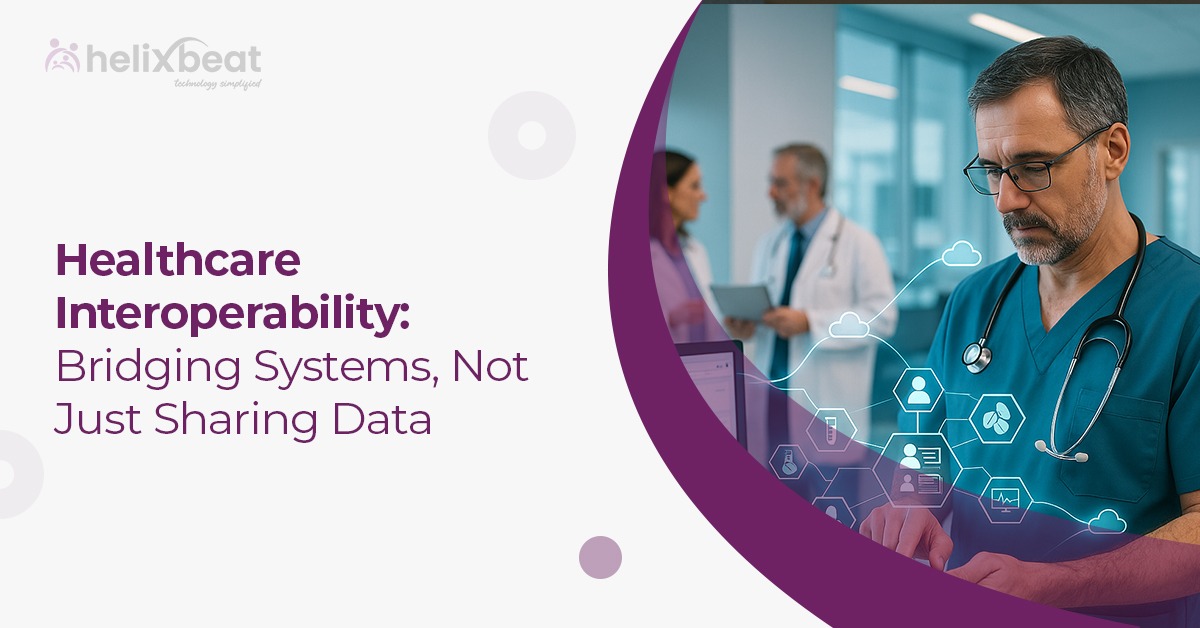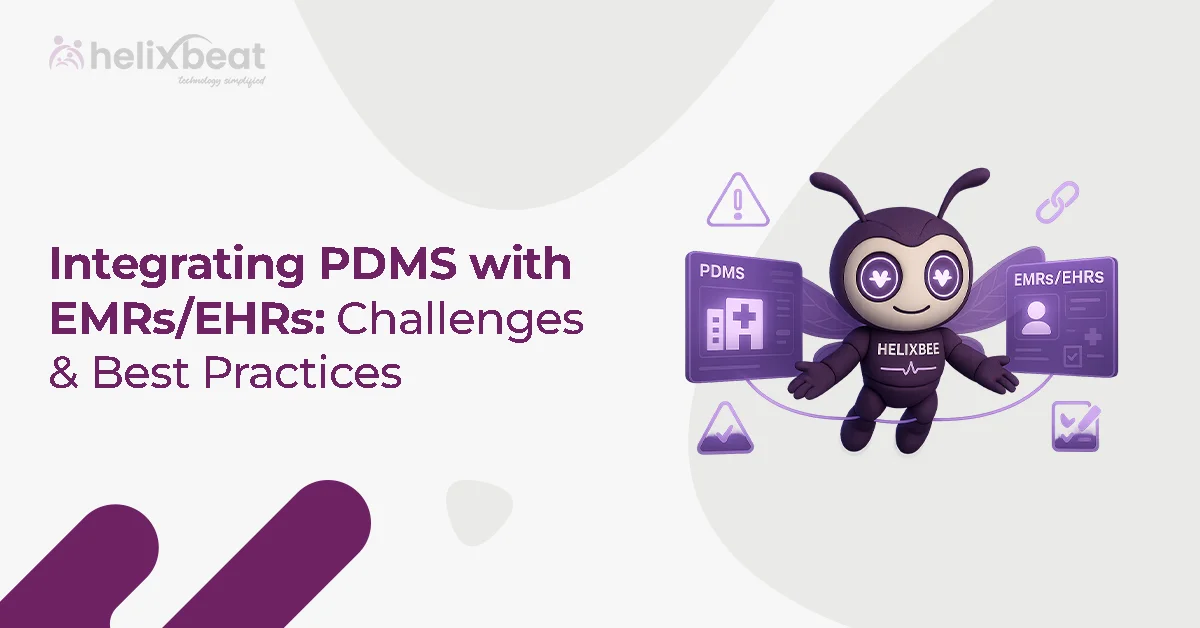You’ve probably heard the term “healthcare interoperability” thrown around a lot. Many think it just means sending data from one system to another. But it’s much more than that. It’s about connecting different healthcare systems, so they work together smoothly, sharing important information in a way that helps patients get the right care at the right time.
In this blog, we’ll discuss what healthcare interoperability really means, why it’s a game-changer for patient care, and how the tools and standards behind it are creating a future where healthcare feels seamless and connected.

Table of Contents
What Is Healthcare Interoperability?
At its core, healthcare interoperability refers to the ability of different healthcare systems, devices, and applications to connect, communicate, and use information cohesively. It’s not just about transferring; it’s about data clarity and usability across systems. This allows healthcare providers to make faster, more informed decisions.
Imagine a patient visiting multiple specialists, hospitals, labs, and pharmacies. Each entity may have its own IT infrastructure — electronic health records (EHRs), lab information systems, imaging software, pharmacy management tools, and more. Healthcare interoperability is the bridge that allows all these diverse systems to talk to each other, sharing the right healthcare data at the right time.
Why Healthcare Interoperability Is More Than Data Exchange
It’s common to think of interoperability as just “data sharing.” However, sharing data without context or understanding can cause confusion and even medical errors. For interoperability to have a real impact:
- Systems must understand the meaning of data: If one system records blood pressure in mmHg and another expects a different unit or format, data becomes useless or misleading.
- Information must be actionable: Providers need not only raw data but also insights that support clinical decisions.
- Security and privacy must be maintained: Sensitive healthcare data requires strict controls when moving across systems.
Therefore, healthcare interoperability involves harmonizing data formats, terminologies, and workflows to create a truly connected healthcare environment.
The Role of Healthcare Data Interoperability Standards
A key driver behind effective healthcare interoperability is the adoption of healthcare data interoperability standards. These standards act as the common language that diverse systems use to exchange and interpret information correctly. Some of the widely recognized standards include:
- HL7 (Health Level Seven): A foundational framework for exchanging clinical and administrative data. HL7 Version 2 has been widely used for decades, while HL7 Version 3 and CDA (Clinical Document Architecture) offer more structure.
- FHIR (Fast Healthcare Interoperability Resources): Developed by HL7 International, FHIR is rapidly becoming the standard for modern healthcare interoperability because it supports RESTful APIs and modern web technologies. FHIR allows developers to build apps that can access healthcare data easily and securely.
- DICOM (Digital Imaging and Communications in Medicine): This standard governs medical imaging data for seamless sharing of images like X-rays and MRIs.
- LOINC (Logical Observation Identifiers Names and Codes): Standardizes laboratory and clinical observations for better data exchange.
How Healthcare Interoperability Platforms Drive Seamless Connectivity
Technology helps translate interoperability into real-world solutions. This is where healthcare interoperability platforms like FUSION come into play. FUSION acts as a centralized hub that:
- Connects multiple disparate systems, such as EHRs, lab systems, and billing software within a hospital.
- Translate different data formats and standards into a unified, understandable form.
- Manage data security and compliance with regulations like HIPAA.
- Provide authorized users with real-time access to patient information.
- Prepares healthcare providers for AI-driven analytics and IoT integration.
For example, a hospital using FUSION can instantly give doctors access to a patient’s lab results from the in-house lab, imaging reports from the radiology department, and medication history from the hospital’s pharmacy, all within the same interface. This level of integration reduces delays, lowers costs, and improves patient outcomes.
Benefits of Healthcare Interoperability Beyond Data Exchange
Healthcare interoperability brings a range of benefits that transform how care is delivered:
1. Improved Patient Safety
When providers have a comprehensive view of a patient’s history, allergies, medications, and test results, they are less likely to make mistakes such as duplicate testing, drug interactions, or misdiagnoses.
2. Enhanced Care Coordination
Chronic disease management often involves multiple care providers. Interoperability facilitates collaboration and smooth transitions between primary care, specialists, hospitals, and home care, which minimizes information gaps.
3. Increased Operational Efficiency
Healthcare staff spend less time on paperwork and tracking down patient records. Automated data sharing speeds up workflows, allowing clinicians to focus more on patients.
4. Better Population Health Management
Aggregated data from various sources helps public health officials identify trends, track outbreaks, and manage resources more effectively.
The Future of Healthcare Interoperability
Looking ahead, healthcare interoperability is evolving toward more patient-centered models where individuals have control over their health data and can share it seamlessly with providers, caregivers, or apps they trust.
Advances in artificial intelligence (AI) and machine learning will leverage interoperable data to provide predictive insights, personalized care plans, and smarter decision support.
Moreover, FHIR-based APIs and cloud technologies will enable innovative digital health apps to integrate smoothly with traditional healthcare IT systems, expanding access and engagement.
Why Choose FUSION
Here’s how FUSION meets and exceeds the critical requirements healthcare organizations look for:
- Seamless Compatibility: FUSION supports HL7 FHIR standards, making integration with your existing systems smooth and efficient.
- Robust Security and Compliance: FUSION incorporates advanced encryption, access controls, and auditing features that comply with healthcare regulations such as HIPAA. .
- Scalable Architecture: Built to grow with your organization, FUSION can handle increasing data volumes and complex workflows without compromising performance or reliability.
- User-Friendly Integration & Support: Designed with usability in mind, FUSION offers easy-to-deploy APIs and comprehensive support for a hassle-free onboarding experience and ongoing assistance.
Final Thoughts
Healthcare interoperability is much more than exchanging data between disconnected systems. It’s about building bridges that connect diverse healthcare technologies into an integrated, responsive, and intelligent network. Discover how FUSION can transform your healthcare ecosystem and drive better outcomes. Contact us today.
FAQs
1. How does healthcare interoperability improve patient outcomes?
By allowing seamless access to comprehensive patient data, healthcare interoperability helps providers make informed decisions, reduce errors, and coordinate care more effectively.
2. Can healthcare interoperability help with population health management?
Yes, interoperable data aggregation enables public health officials and providers to track trends, manage outbreaks, and design effective health programs.
3. How does healthcare interoperability protect patient privacy and security?
Interoperability platforms use encryption, access controls, and compliance with regulations like HIPAA to safeguard sensitive healthcare data during exchange.
4. What role does FHIR play in healthcare interoperability?
FHIR is a modern standard that facilitates fast, flexible, and secure data exchange using web-based APIs, making it easier to build interoperable healthcare applications.
5. How can healthcare organizations start implementing healthcare interoperability?
Organizations should assess existing systems, adopt relevant standards, invest in interoperability platforms, and promote collaboration among stakeholders to build connected care networks.














